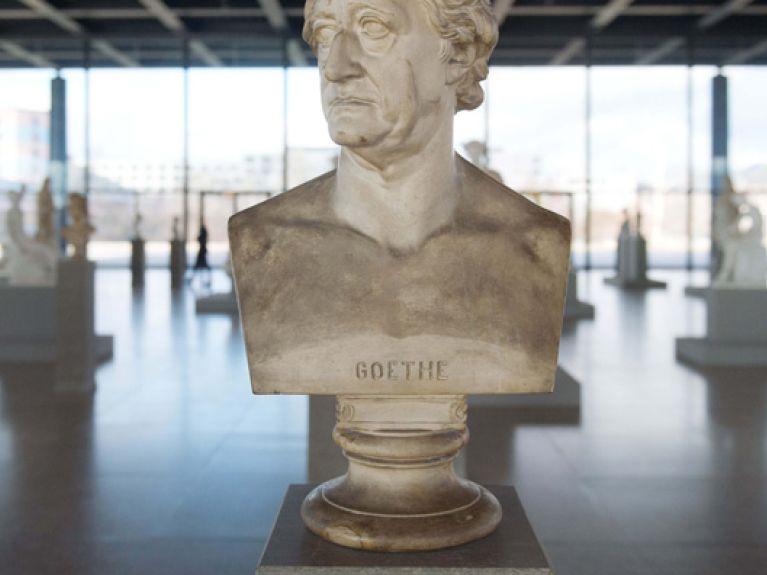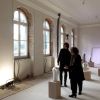Happiness is a museum
Almost no other country has as rich a museum landscape as Germany – and it is not only thriving in big cities.

The diversity of the German museum landscape
Germany has by far more museums, exhibition halls and galleries than any other country, and nowhere else are exhibitions as well attended as in Germany. From the summit of the Zugspitze mountain to the dunes on the island of Spiekeroog – everywhere visitors find sculptures, paintings and installations. And the number of collections in the fields of culture, natural history, ethnology and local history is still growing. Within a few years it has doubled to more than 6,500. More people now go to exhibitions than to soccer matches. The museum has become one of today’s most popular mediums of education and entertainment – and it is still by no means popular enough.
After all, who is aware of the incredible treasures out there: the Botticelli hanging in Hanover, the Vermeer in Braunschweig, the whole room full of Rembrandts waiting for visitors in Kassel, and even Greifswald has a van Gogh to show for itself. The German museum landscape is more a museum jungle – teeming, impenetrable, full of astonishing blossoms and always good for new discoveries. Anyone who thinks they know art history, who believes that the museums around the country all show the same canon, a variation of evergreens, will soon be surprised and proved wrong. They only have to look around, travel a bit. For while in other countries the greatest treasures are consistently on show in the largest cities, in Germany such riches have always thrived in the provinces as well. Every halfway enlightened prince delighted in having his own – often idiosyncratic – collection, and as a result Altenburg, Karlsruhe and Schwerin can still boast of being centres of the arts to this very day.
Burghers in the 19th century, however, were also enthusiastic about painting and sculpture and founded so many museums and art societies that it was sometimes believed the Germans had a special collector-gene. Yet it was probably German history that awakened a passion for art in many people. A “belated nation” looked towards culture for those common, absolute values that could long not be found in the political arena of German Kleinstaaterei, or regionalism. The many new museums expressed self-confidence, indicating that the people had a history – and, what is more, a future! Many regarded their art institutions as centres of knowledge and aesthetic adventure. In Germany in particular, there were private collectors and state museum directors who, at an early stage, threw open their doors to modernism, often enough in the face of considerable protest from the general public. In Hagen a special museum for contemporary art was set up long before the Museum of Modern Art came into being in New York City. Had it not been for the National Socialists, who rid the German collections of everything they considered “degenerate”, the wealth of avant-garde art would still be unique today.
As it was, much was lost; numerous artworks were destroyed or sold, numerous artists had to flee for their lives. Most museums are still suffering from that act of self-privation to this very day. Yet, odd as it may sound, that loss had another effect. Because modernism had been condemned there, people in the Federal Republic felt particularly committed to it. Innovative exhibition formats like the documenta in Kassel stimulated the curiosity of a wide public. Collectors, gallery owners and museum directors too encouraged artists from home and abroad and promoted an art that was provocative and experimental. On the rivers Rhine and Ruhr, in particular, a number of new art galleries were set up in the post-war era which still testify to the fact that, despite the conservatism of those “economic boom years”, there was also a determination to support the aesthetically audacious.
The great museum boom did not really begin until the 1980s, however, and was powered by large donations from private collectors. In addition, many cities realized that the arts were an important factor for economic development and sought to attract business and improve their image with striking buildings and spectacular exhibitions. The Culture for All concept that still characterized the late “wild” 1960s gradually gave way to an Events for All ideology. As in television, ratings were also applied to museums as a measure of their success.
Today, art is a growth market with some 5,000 special exhibitions a year in Germany alone. And the trend is upwards. Even more so than in the past, the primacy of the big names and the big numbers prevails. With each new building, each new inauguration, the competition between the museums increases and the longing for variety, for super-shows, becomes more intense. But the Old Masters can scarcely offer all that. Usually they cannot make long journeys, they do not like to be exposed to the breath of the thousands, they do not really suit the logic of the society of the spectacle. And that logic does not suit the museum as it once was. It used to thrive on peaceful isolation, on the fact that things in a museum seemed detached and immutable. There you could see what your grandparents had already seen, and what your great-grandchildren would see. It was a site of reliability, permanence. But most visitors now are drawn by the temporary, the promise of uniqueness, of something that never was before and never will be again. In the meantime, according to the director of the Hamburger Kunsthalle, only roughly 10% of visitors come to see the permanent collection.
This is not the least of the reasons why many museums look like mere exhibition halls. The fact that museums engage in research, preserve objects and collect and exhibit art, while an exhibition hall just organizes special shows without building and maintaining a collection of its own is a difference the general public seems to have forgotten. Many museums even seem to be ashamed of their permanent collections, locking them up in the basement to make room for temporary exhibitions.
Things do not have to be like this. The smaller the budgets get, the harder it becomes to find big sponsors for big events and the more museums seem to be reflecting on their past. People are gradually beginning to realize that the constant is also something special, that it is worth teasing out what is characteristic of one’s own collection and that a re-hanging can sometimes be much more exciting than yet another Picasso or Warhol exhibition. And this change of heart is already being implemented in Berlin, Dusseldorf and Stuttgart.
For museum lovers, the motto is: leave the well-trodden paths, discover the incredible wealth of collections, the luxury of an intimate proximity to art that only the wealthiest can afford – and which everyone can enjoy in a museum. Often, this form of happiness is to be found where it is least expected, waiting modestly on the sidelines. Often we find it where we are on our own, in the eye of art, so to speak. It is the happiness engendered by astonishment at how uncommonly rich humankind’s creations are, and how wealthy those of us are who are able to observe those creations. And so we are astonished not least about the fact that we are astonished – and we know why museums exist.

